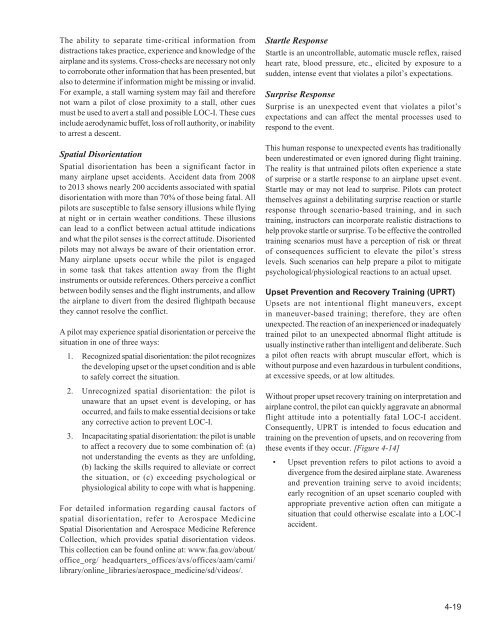You also want an ePaper? Increase the reach of your titles
YUMPU automatically turns print PDFs into web optimized ePapers that Google loves.
The ability to separate time-critical information from<br />
distractions takes practice, experience and knowledge of the<br />
airplane and its systems. Cross-checks are necessary not only<br />
to corroborate other information that has been presented, but<br />
also to determine if information might be missing or invalid.<br />
For example, a stall warning system may fail and therefore<br />
not warn a pilot of close proximity to a stall, other cues<br />
must be used to avert a stall and possible LOC-I. These cues<br />
include aerodynamic buffet, loss of roll authority, or inability<br />
to arrest a descent.<br />
Spatial Disorientation<br />
Spatial disorientation has been a significant factor in<br />
many airplane upset accidents. Accident data from 2008<br />
to 2013 shows nearly 200 accidents associated with spatial<br />
disorientation with more than 70% of those being fatal. All<br />
pilots are susceptible to false sensory illusions while flying<br />
at night or in certain weather conditions. These illusions<br />
can lead to a conflict between actual attitude indications<br />
and what the pilot senses is the correct attitude. Disoriented<br />
pilots may not always be aware of their orientation error.<br />
Many airplane upsets occur while the pilot is engaged<br />
in some task that takes attention away from the flight<br />
instruments or outside references. Others perceive a conflict<br />
between bodily senses and the flight instruments, and allow<br />
the airplane to divert from the desired flightpath because<br />
they cannot resolve the conflict.<br />
A pilot may experience spatial disorientation or perceive the<br />
situation in one of three ways:<br />
1. Recognized spatial disorientation: the pilot recognizes<br />
the developing upset or the upset condition and is able<br />
to safely correct the situation.<br />
2. Unrecognized spatial disorientation: the pilot is<br />
unaware that an upset event is developing, or has<br />
occurred, and fails to make essential decisions or take<br />
any corrective action to prevent LOC-I.<br />
3. Incapacitating spatial disorientation: the pilot is unable<br />
to affect a recovery due to some combination of: (a)<br />
not understanding the events as they are unfolding,<br />
(b) lacking the skills required to alleviate or correct<br />
the situation, or (c) exceeding psychological or<br />
physiological ability to cope with what is happening.<br />
For detailed information regarding causal factors of<br />
spatial disorientation, refer to Aerospace Medicine<br />
Spatial Disorientation and Aerospace Medicine Reference<br />
Collection, which provides spatial disorientation videos.<br />
This collection can be found online at: www.faa.gov/about/<br />
office_org/ headquarters_offices/avs/offices/aam/cami/<br />
library/online_libraries/aerospace_medicine/sd/videos/.<br />
Startle Response<br />
Startle is an uncontrollable, automatic muscle reflex, raised<br />
heart rate, blood pressure, etc., elicited by exposure to a<br />
sudden, intense event that violates a pilot’s expectations.<br />
Surprise Response<br />
Surprise is an unexpected event that violates a pilot’s<br />
expectations and can affect the mental processes used to<br />
respond to the event.<br />
This human response to unexpected events has traditionally<br />
been underestimated or even ignored during flight training.<br />
The reality is that untrained pilots often experience a state<br />
of surprise or a startle response to an airplane upset event.<br />
Startle may or may not lead to surprise. Pilots can protect<br />
themselves against a debilitating surprise reaction or startle<br />
response through scenario-based training, and in such<br />
training, instructors can incorporate realistic distractions to<br />
help provoke startle or surprise. To be effective the controlled<br />
training scenarios must have a perception of risk or threat<br />
of consequences sufficient to elevate the pilot’s stress<br />
levels. Such scenarios can help prepare a pilot to mitigate<br />
psychological/physiological reactions to an actual upset.<br />
Upset Prevention and Recovery Training (UPRT)<br />
Upsets are not intentional flight maneuvers, except<br />
in maneuver-based training; therefore, they are often<br />
unexpected. The reaction of an inexperienced or inadequately<br />
trained pilot to an unexpected abnormal flight attitude is<br />
usually instinctive rather than intelligent and deliberate. Such<br />
a pilot often reacts with abrupt muscular effort, which is<br />
without purpose and even hazardous in turbulent conditions,<br />
at excessive speeds, or at low altitudes.<br />
Without proper upset recovery training on interpretation and<br />
airplane control, the pilot can quickly aggravate an abnormal<br />
flight attitude into a potentially fatal LOC-I accident.<br />
Consequently, UPRT is intended to focus education and<br />
training on the prevention of upsets, and on recovering from<br />
these events if they occur. [Figure 4-14]<br />
• Upset prevention refers to pilot actions to avoid a<br />
divergence from the desired airplane state. Awareness<br />
and prevention training serve to avoid incidents;<br />
early recognition of an upset scenario coupled with<br />
appropriate preventive action often can mitigate a<br />
situation that could otherwise escalate into a LOC-I<br />
accident.<br />
4-19


